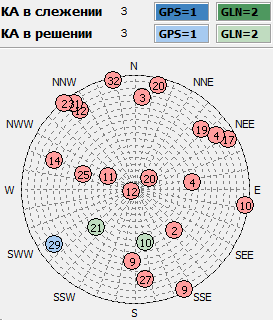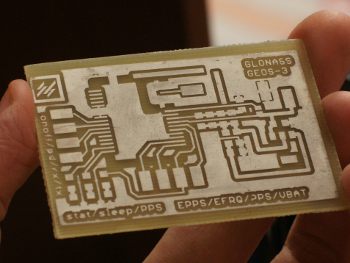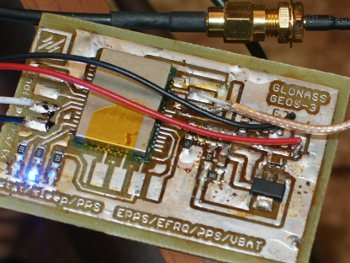GLONASS module GEOS-3: connection and use
 wanted to touch GLONASS, but until recently the price of plug-ins with support for GLONASS was absolutely indecent, as well as their availability. By chance, I got an engineering sample GLONASS+GPS module GEOS-3 (it goes into series production in March-April 2012), and my results of working with him I would like to share.
wanted to touch GLONASS, but until recently the price of plug-ins with support for GLONASS was absolutely indecent, as well as their availability. By chance, I got an engineering sample GLONASS+GPS module GEOS-3 (it goes into series production in March-April 2012), and my results of working with him I would like to share.Why do we need GLONASS if GPS is working fine? Right as just such an example. With 23 satellites above the horizon, the window shows only 3, 1 GPS and 2 GLONASS. In such circumstances, no matter how cool the GPS receiver may be, he will not be able to determine the coordinates at all, and for the combined GPS+GLONASS receiver, there are fatal problems there.
 the Module has dimensions 15.9*22.1*2.5 mm, and its use has been relatively easy: connect all the GND contacts to the ground, serves 3.3 V and 1.8 V power to the appropriate pins (3.3 V is voltage, I/o, it can also be 1.8 V), connect the antenna to the ANT. If an active antenna (with amplifier and requires power), then the V_ANT input also serves 3.3 V. then using RX0 and TX0 (COM port) can be connected to the microcontroller or PC (the PC though a COM port outputs +12V and -12V, you need a Converter to 3.3 V, for example the MAX3232 chip). All unused pins can simply will not connect.
the Module has dimensions 15.9*22.1*2.5 mm, and its use has been relatively easy: connect all the GND contacts to the ground, serves 3.3 V and 1.8 V power to the appropriate pins (3.3 V is voltage, I/o, it can also be 1.8 V), connect the antenna to the ANT. If an active antenna (with amplifier and requires power), then the V_ANT input also serves 3.3 V. then using RX0 and TX0 (COM port) can be connected to the microcontroller or PC (the PC though a COM port outputs +12V and -12V, you need a Converter to 3.3 V, for example the MAX3232 chip). All unused pins can simply will not connect.Briefly, the remaining conclusions: V_BAT is for lithium batteries for storage of almanac and ephemeris when the device is disabled to speed up re-acquisition of satellites. 1PPS second mark with precision 30ns (e.g. for the NTP servers of exact time, this I can do), E_PPS/E_FRQ input of the time signal to increase the accuracy and speed of capture coordinates in assisted mode (will work in the release firmware). PD — enabling reduced energy consumption when 90% of the time the module sleeps, and 10% of works, will also work in the release firmware.
Connected
 For this module I made a library symbol in Eagle, and spread a simple test fee allows you to measure current consumption. Download my Board and library here. When I bred cost forgot that the bottom of the debug module connector, so I had to stick it kapetanovo tape in the library symbol already contains a ban on the debug trace under the connector. The wiring should pay attention only to the antenna connection (top right of the module) — the land surrounds the antenna's connection from all sides, and connected to a common ground at one point to excessive noise not to catch.
For this module I made a library symbol in Eagle, and spread a simple test fee allows you to measure current consumption. Download my Board and library here. When I bred cost forgot that the bottom of the debug module connector, so I had to stick it kapetanovo tape in the library symbol already contains a ban on the debug trace under the connector. The wiring should pay attention only to the antenna connection (top right of the module) — the land surrounds the antenna's connection from all sides, and connected to a common ground at one point to excessive noise not to catch.Active antenna and SMA connectors was bought at DealExtreme. As the frequency nearly coincide with the GPS antenna works fine with GPS and GLONASS satellites.
 Sealing module to a fee of not more chips in SOIC-housing: need a normal soldering iron and liquid flux (LTI-120 in my case), then all is wetted with flux, and the surface tension itself will do all the work. I overreacted, and used low melting point solder (Sn43 Bi14) to make it easier to blow away a module, a Hairdryer in case of an error, but doing so is not needed.
Sealing module to a fee of not more chips in SOIC-housing: need a normal soldering iron and liquid flux (LTI-120 in my case), then all is wetted with flux, and the surface tension itself will do all the work. I overreacted, and used low melting point solder (Sn43 Bi14) to make it easier to blow away a module, a Hairdryer in case of an error, but doing so is not needed.Earned all at once and no dancing with a tambourine is not required. And of course, you can buy a ready-made target Board (issue price of ~400$, but now can't find link).
Use
From a programmatic point of view, the module, in the simplest case, is no different from GPS on the same NMEA Protocol (also there's a binary Protocol). There is a test program GeoSDemo for windows that allows you to touch all that is available on the module and upgrade the firmware.
The time when the coordinates of a cold inclusion and visibility in the "floor of heaven" was about 90 seconds (sometimes less, sometimes a little more), usually see 10-13 satellites, equally GLONASS and GPS. At a voltage of 1.85 V (slightly above normal) current consumption amounted to 61мА without the power saving mode (when tracking satellites, and when there is a capture — consumption I did the same).
With a positioning accuracy in the test firmware have problems — sometimes wrong >10m, manufacturer I wrote about it, and told me to wait for release test firmware for it and test.
The question price — 28$ single copies (now there are apparently engineering samples are), wholesale — to$ 15. These prices, though higher than the Chinese modules on the ancient SiRF Star III, but not so much. Will also be Geos-3M — the same, only in a more compact package.
So now you can finally say that GLONASS has become quite affordable to use even by Amateurs
PS. Who knows how to calculate the patch antenna on FR4 1.5 mm for the GPS/Glonass frequency (1575Mhz + 1602Mhz, only L1 band)? I want to try the antenna on the Board to integrate.
Комментарии
Отправить комментарий